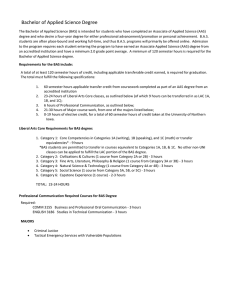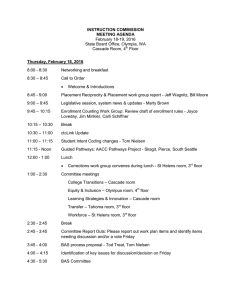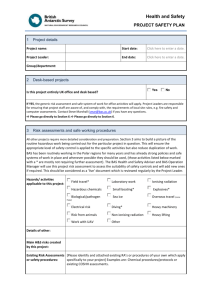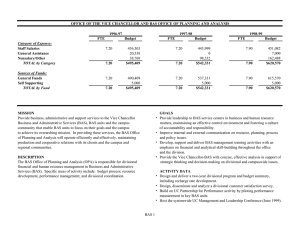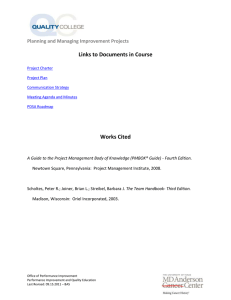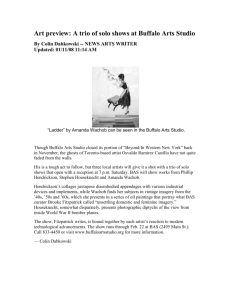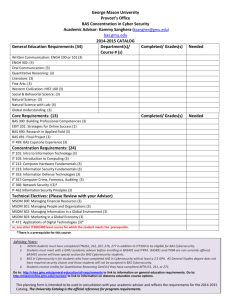INSECTICIDE EFFICACY TRIALS IN TOMATO, CABBAGE AND SQUASH University of Georgia
advertisement
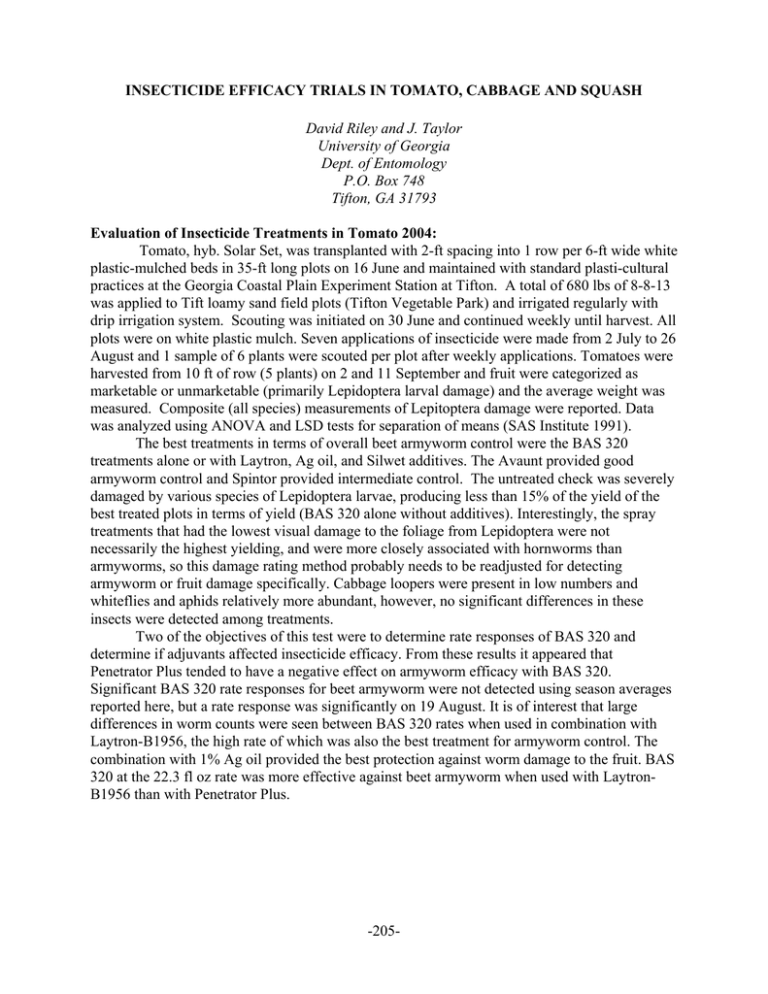
INSECTICIDE EFFICACY TRIALS IN TOMATO, CABBAGE AND SQUASH David Riley and J. Taylor University of Georgia Dept. of Entomology P.O. Box 748 Tifton, GA 31793 Evaluation of Insecticide Treatments in Tomato 2004: Tomato, hyb. Solar Set, was transplanted with 2-ft spacing into 1 row per 6-ft wide white plastic-mulched beds in 35-ft long plots on 16 June and maintained with standard plasti-cultural practices at the Georgia Coastal Plain Experiment Station at Tifton. A total of 680 lbs of 8-8-13 was applied to Tift loamy sand field plots (Tifton Vegetable Park) and irrigated regularly with drip irrigation system. Scouting was initiated on 30 June and continued weekly until harvest. All plots were on white plastic mulch. Seven applications of insecticide were made from 2 July to 26 August and 1 sample of 6 plants were scouted per plot after weekly applications. Tomatoes were harvested from 10 ft of row (5 plants) on 2 and 11 September and fruit were categorized as marketable or unmarketable (primarily Lepidoptera larval damage) and the average weight was measured. Composite (all species) measurements of Lepitoptera damage were reported. Data was analyzed using ANOVA and LSD tests for separation of means (SAS Institute 1991). The best treatments in terms of overall beet armyworm control were the BAS 320 treatments alone or with Laytron, Ag oil, and Silwet additives. The Avaunt provided good armyworm control and Spintor provided intermediate control. The untreated check was severely damaged by various species of Lepidoptera larvae, producing less than 15% of the yield of the best treated plots in terms of yield (BAS 320 alone without additives). Interestingly, the spray treatments that had the lowest visual damage to the foliage from Lepidoptera were not necessarily the highest yielding, and were more closely associated with hornworms than armyworms, so this damage rating method probably needs to be readjusted for detecting armyworm or fruit damage specifically. Cabbage loopers were present in low numbers and whiteflies and aphids relatively more abundant, however, no significant differences in these insects were detected among treatments. Two of the objectives of this test were to determine rate responses of BAS 320 and determine if adjuvants affected insecticide efficacy. From these results it appeared that Penetrator Plus tended to have a negative effect on armyworm efficacy with BAS 320. Significant BAS 320 rate responses for beet armyworm were not detected using season averages reported here, but a rate response was significantly on 19 August. It is of interest that large differences in worm counts were seen between BAS 320 rates when used in combination with Laytron-B1956, the high rate of which was also the best treatment for armyworm control. The combination with 1% Ag oil provided the best protection against worm damage to the fruit. BAS 320 at the 22.3 fl oz rate was more effective against beet armyworm when used with LaytronB1956 than with Penetrator Plus. -205- Table 1. Tomato scout and yield data from a Tifton, Georgia Summer test 2004 - University of Georgia. Treatment (rate and spray schedule1) total armyworm Small armyworm Large armyworm Hornworm % Worm Damage2 Untreated Check 1.56ab* 0.47a 1.09abc 0.41a 59 a 2.38d F1785 50 DF 0.071 LB AI/A or 0.142 LB/A (ABCDE) 1.72a 0.09bc 1.63a 0.34abc 29 cd 3.76cd BAS 320 UHI 27.4 FL OZ/A (AC) + Penetrator Plus 16 Fl OZ/A 1.50abc 0.28abc 1.22ab 0.22abcd 58 ab 4.08cd F1785 50 DF 0.054 LB AI/A or 0.108 LB/A (ABCDE) 1.25abcd 0.31abc 0.94abcd 0.38ab 35 abc 3.49cd BAS 320 UHI 27.4 FL OZ/A (BD) + Penetrator Plus 16 FL OZ/A 1.00abcde 0.22abc 0.78bcde 0.13cd 29 cd 6.46bcd BAS 320 UHI 22.3 FL OZ/A (ABCDE)+ Penetr. Plus 16 FL OZ/A 0.94abcde 0.28abc 0.66bcde 0.16bcd 34 bc 10.16abcd BAS 320 UHI 18.3 FL OZ/A (ABCDE) + Penetr. Plus 16 FL OZ/A 0.78bcdef 0.09bc 0.69bcde 0.13cd 26 cd 10.42abcd BAS 320 UHI 18.3 FL OZ/A (ABCDE)+Layt.-B1956 5 FL OZ/A 0.75bcdef 0.13bc 0.63bcde 0.16bcd 23 cd 10.96abc Spintor 2SC 6 FL OZ/A (ABCDE)+ Penetrator Plus 16 FL OZ/A 0.69cdef 0.06bc 0.63bcde 0.13cd 22 cd 13.00ab BAS 320 UHI 22.3 FL OZ/A (ABCDE) 0.63def 0.34ab 0.25de 0.13cd 18 cd 16.09a BAS 320 UHI 27.4 FL OZ/A (ABCD) + Pentrator Plus 16 FL OZ/A 0.56def 0.25abc 0.31cde 0.16bcd 19 cd 8.00abcd BAS 320 UHI 18.3 FL OZ/A (ABCDE)+ Silwet 5 FL OZ/A 0.53def 0.09bc 0.44bcde 0.19abcd 20 cd 10.68abcd BAS 320 UHI 22.3 FL OZ/A (ABCDE)+ Silwet 5 FL OZ/A 0.50def 0.09bc 0.41cde 0.13cd 14 cd 8.91abcd BAS 320 UHI 18.3 FL OZ/A (ABCDE)+ Ag oil (1%) 96 FL OZ/A 0.41ef 0.03bc 0.31cde 0.06d 15 cd 13.22ab BAS 320 UHI 27.4 FL OZ/A (BCDE) + Penetr. Plus 16 FL OZ/A 0.38ef 0.22abc 0.13e 0.13cd 20 cd 15.48a BAS 320 UHI 18.3 FL OZ/A (ABCDE) 0.34ef 0.03bc 0.28de 0.19abcd 12 cd 15.72a Avaunt 3.34 OZ WT/A (ABCDE) + Penetrator Plus 16 FL OZ/A 0.31ef 0.06bc 0.25de 0.09dc 14 cd 13.32ab BAS 320 UHI 22.3 FL OZ/A (ABCDE)+ Ag oil (1%) 96 FL OZ/A 0.25ef 0.06bc 0.19de 0.25abcd 8d 15.27a BAS 320 UHI 22.3 FL OZ/A (ABCDE)+Layt.-B1956 5 FL OZ/A 0.06f 0.00c 0.06e 0.13cd 25 cd 2 Rate in product per acre, spray schedules corresponds to A=1st spray, B=2nd spray, etc. with E=seven sprays until harvest. first harvest only * Means within columns followed by the same letter are not significantly different (P>0.05, LSD test). 1 -206- Marketable tomato wt(lb) 15.64a Evaluation of Insecticide Treatments in Cabbage, 2004: Cabbage ‘Bravo’ was transplanted into 2 rows per 6-ft beds on 11 Mar, reset on 12 Mar, 16 Mar and maintained with standard cultural practices at the Lang Farm, Georgia Coastal Plain Experiment Station at Tifton. A total of 300 lbs of 10-10-10 was applied to Tift pebbly clay loam field plots and irrigation regularly with an overhead sprinkler system. Scouting was initiated on 18 Mar and continued weekly until harvest. Nine applications of insecticide were made from 31 Mar and 1 sample of 6 plants were scouted per plot approximately 48 h after weekly applications. Small (1st to 3rd instar) larvae and large (4th to 6th instar) larvae of diamondback moth (DBM), cabbage looper (CL), and imported cabbage worm (ICW) we recorded per 6-plant sample. Cabbage was harvested from 10 ft of row (10 head) on 1 June, and 11 June 5 ft of row (5 head) and heads and wrapper damage were rated as severely (3), moderately (2), slightly (1) or not damaged (0) and the head weight was measured. Data was analyzed using ANOVA and LSD tests for separation of means (SAS Institute 1991). The best treatments in terms of overall efficacy against Lepidoptera larvae were Novaluron combinations with either Avaunt or Spintor, the BAS 320 UH treatments, followed by the Avaunt, Novaluron, Intrepid + Xentari, and Spintor treatments. These treatments also had the lowest damage to the head of cabbage with Novaluron exhibiting the lowest level of damage possibly suggesting anti-feeding properties. In terms of total DBM, the top treatments listed above performed well. Asana, Intrepid and Xentari alone did not control DBM in this test, but the Intrepid + Xentari combination did result in significant DBM control. All treatments provided adequate control of ICW. The weakest treatment, Asana, did control CL and ICW as well as most of the other treatments. Thus it appeared that DBM was the critical pest species for determining damage to the crop. There were no significant differences of total head weights per plot, but there were significant differences in marketable head weights between all treatments and the check. Of interest was that the high rate of Novaluron had a lower marketable weight even though the damage was very low for this treatment. This might indicate a slight phytotoxic effect at the highest rate, but no foliar symptoms were noted during the test. Table 2. Number of lepidopterous larvae, damage and yield observed per six plants in a -207- cabbage test at Tifton, Georgia. Treatment # - insecticide Rate amt/acre Untreated Check Total Larvae DBM Total CL Total ICW Total Damage rating for wrapper damage (0-3) Damage rating for head damage (0-3) Weight lb marketable heads per 15 plants 4.33a 1.47a 0.53a 2.33a 2.4a 1.83a 30.7c Asana XL 0.66 EC 0.02 lbs ai/a 1.61b 1.08a 0.11b 0.42bc 1.37bc 0.82bcd 57.2b Intrepid 2F 8 floz Pr/a 1.11bc 1.19a 0.03b 0.25bc 1.43b 1.12b 63.9ab XenTari 1 lb Pr/a 1.42bcd 0.97a 0.03b 0.42bc 1.10cde 0.60defg 86.4a Intrepid 2F + Asana XL 0.66 EC 8 floz Pr/a 0.02lbs ai/a 1.14bcde 0.89ab 0.00b 0.25bc 1.32bcd 0.77bcde 66.0ab Intrepid 2F 12 floz Pr/a 1.11bcde 0.92ab 0.00b 0.19bc 1.42b 1.02bc 72.2ab Spintor 2SC 5 floz Pr/a 0.72bcdef 0.33bc 0.14b 0.25bc 1.05de 0.42efgh 70.8ab Novaluron 0.83 EC 14 oz Pr/a 0.69cdef 0.06c 0.00b 0.64b 0.57fg 0.18h 58.1b Intrepid 2F + XenTari 8 floz Pr/a 1lb Pr/a 0.67cdef 0.36bc 0.00b 0.31bc 0.82ef 0.38fgh 65.4ab Novaluron 0.83 EC 12 oz Pr/a 0.61def 0.17c 0.03b 0.42bc 0.35g 0.15h 79.4ab Avaunt 30 WG 0.065 lbai/a 0.42ef 0.08c 0.08b 0.25bc 0.82ef 0.37gh 83.6a BAS 320 UH + Penetrator Plus 22.8 floz /a 0.36ef 0.08c 0.06b 0.22bc 1.13bcd 0.73cdef 72.4ab BAS 320 UH + Penetrator Plus 27.4 floz /a 0.36ef 0.11c 0.03b 0.22bc 1.10cde 0.47defgh 71.9ab Novaluron 0.83 EC/Spintor 2SC 12 floz Pr/a 5 floz Pr/a 0.33ef 0.03c 0.03b 0.28bc 0.68f 0.28gh 69.0ab 0.11c 0.72f 0.30gh 77.9ab Novaluron 0.83 EC/Avaunt 30 WG 12 floz Pr/a 0.19f 0.08c 0.00b 5 floz Pr/a * Means within columns followed by the same letter are not significantly different (LSD, P>0.05). -208- Evaluation of Insecticide Treatments in Squash Test, 2004: Yellow squash was direct seeded into 2 rows per 6-ft bed on 19 August and maintained with standard cultural practices at the Hort Hill Farm, Georgia Coastal Plain Experiment Station at Tifton. A total of 120 lbs of 10-10-10 and 120 lbs 21-0-0 per half acre was applied to Tift sandy clay loam field plots. Scouting was initiated on 8 September and continued weekly until harvest. A saecond planting of squash was direct seeded on 28 October in the same plots for additional efficacy data since Lepidoptera pest were not present in the first plant. Only scouting data was taken from this planting. Three applications each of insecticide were made from 31 August to 14 September on the first planting and from 4 - 18 November in the second planting. Two applications of fungicide (Ridomyl Bravo) were made later in the season. Scouting of 6 plants per plot was conducted weekly. Also, 6 leaves per plot were collected and counted for whitefly eggs and nymphs and melon aphids, winged adults and nymphs from the first planting. Squash was harvested 30 September, but yield was too low (likely because of weather related damage, two tropical storms) to detect significant treatment effects. Like wise yield was not available for the later planting due to cold weather. Data was analyzed using GLM and LSD tests for separation of means (SAS Institute 1985). There were no significant differences in terms of overall whitefly or aphid numbers in the first planting under low whitefly pressure (0-3 nymphs per leaf). The second planting of squash experienced moderately high melon worm pressure and treatment differences were detected. All insecticide treatments significantly reduced melonworm compared to the check. No significant rate response was detected with Novaluron in terms of melonworm control in this test. Novaluron was an effective treatment for melonworm. -209- Table 3. Insecticide effects on silverleaf whitefly and aphids on leaf disks from first planting and melon worm on whole plants from second planting, Tifton 2004. Treatment - rate per acre Melon Worm 11/9/04 Melon Worm 11/11/04 Melon Worm 11/17/04 Melon Worm 11/19/04 Melon Worm over all dates Whitefly eggs over all dates Whitefly nymphs over all dates Aphids over all dates Novaluron 0.078 lb AI 1.25 b 2.50 ab 0.00 b 0.25 b 1.00 b 1.2 a 1.3 a 1.1 a Novaluron 0.058 lb AI 2.00 b 0.50 bc 0.00 b 0.25 b 0.69 b 0.5 a 1.2 a 0.9 a Novaluron 0.078 lb AI + Admire drench 0.25 lb AI 0.50 b 0.00 c 0.50 b 0.00 b 0.25 b 3.0 a 3.3 a 1.4 a Warrior 0.03 lb AI 0.00 b 0.00 c 0.00 b 0.00 b 0.00 b 1.4 a 0.8 a 0.9 a Untreated Check 5.75 a 4.25 a 2.75 a 4.00 a 4.19 a 3.0 a 1.5 a 1.4 a * Means within columns followed by the same letter are not significantly different (LSD, P<0.05). M = marginally significant differences (treatment effect P<0.10) -210-
